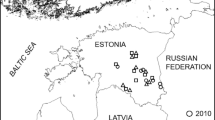Abstract
Phytophthora infestans (Mont.) de Bary, the causal agent of potato late blight, was first discovered in Europe in 1845. Until 1980, only A1 mating type isolates were known to occur in Europe. The absence of A2 mating type isolates restrained the fungus from sexual reproduction. In the early 1980s, A2 mating type isolates were discovered in Europe. Presumably, a new introduction ofP. infestans isolates originating from Mexico had taken place. In this paper, the significance of the presence of A1 and A2 mating type isolates in the Netherlands is reviewed. Now that both mating types are present, sexual reproduction can occur and its consequences for the control of potato late blight are discussed.
Similar content being viewed by others
References
Bourke, P.M.A., 1964. Emergence of potato blight, 1843–46. Nature 203: 805–808.
Clinton, G.P., 1911. Oospores of potato blight. Science 33: 744–747.
Davidse, L.C., Looijen, D., Turkensteen, L.J. & Van der Wal, D., 1981. Occurrence of metalaxylresistant strains ofPhytophthora infestans in the Netherlands. European Plant Protection Organization. Bulletin 15: 403–409.
de Bary, A., 1876. Researches into the nature of the potato fungusPhytophthora infestans. Journal of the Royal Agricultural Society of England 12: 239–269.
Drenth, A., Goodwin, S.B., Fry, W.E. & Davidse, L.C., 1993. Genotypic diversity ofPhytophthora infestans in the Netherlands revealed by DNA polymorphisms. Phytopathology 83: 1087–1092.
Duncan, J.M., 1980. Persistence of mycelium ofPhytophthora fragariae in soil. Transactions of the British Mycological Society 75: 383–387.
Fry, W.E., Goodwin, S.B., Matuszak, J.M., Spielman, L.J., Milgroom, M.G. & Drenth, A., 1992. Population genetics and intercontinental migrations ofPhytophthora infestans. Annual Review of Phytopathology 30: 107–129.
Gallegly, M.E. & Galindo, J., 1958. Mating types and oospores ofPhytophthora infestans in nature in Mexico. Phytopathology 48: 274–277.
Goodwin, S.B., 1991. DNA polymorphisms inPhytophthora infestans: the Cornell experience. In: Lucas, J. A., Shattock, R. C., Shaw, D. S. & Cooke, L. R. (Eds),Phytophthora. British Mycological Society, Cambridge University Press, Cambridge, p. 256–271.
Goodwin, S.B., Drenth, A. & Fry, W.E., 1992a. Cloning and genetic analyses of two highly polymorphic, moderately repetitive nuclear DNAs fromPhytophthora infestans. Current Genetics 22: 107–115.
Goodwin, S.B., Spielman, L.J., Matuszak, J.M., Bergeron, S.N. & Fry, W.E., 1992b. Clonal diversity and genetic differentiation amongPhytophthora infestans populations in northern Mexico. Phytopathology 82: 955–961.
Götz, E., 1990. New aspects relating toPhytophthora control in potatoes./Neue Aspekte bei der Bekampfung der Phytophthora in Kartoffeln. Kartoffelbau 6: 224–226.
Götz, E., 1991. Untersuchungen zum Auftreten des A2-Paarungstyps beiPhytophthora infestans (Mont.) de Bary in Ostdeutschland. Potato Research 34: 233–237.
Hemmes, D.E., 1983. Cytology ofPhytophthora. In: Erwin, D.C., Bartnicki-Garcia, S. & Tsao, P.H. (Eds),Phytophthora, its biology, taxonomy, ecology and pathology. APS Press. p. 9–40.
Hohl, H.R. & Iselin, K., 1984. Strains ofPhytophthora infestans with A2 mating type behaviour. Transactions of the British Mycological Society 83: 529–530.
Mooi, J.C., 1968. Onderzoek naar het voorkomen van ‘hogere’ fysio’s vanPhytophthora infestans in de Groninger Veenkolonien en aangrenzend bebied in 1968. Resultaten proefvelden fabrieks-aardappelen 1968: 54–57
Mooi, J.C., 1971. Het optreden van fysio’s vanPhytophthora infestans in de Groninger Veenkolonien en omgeven gebied in 1970 en 1971. Resultaten proefvelden fabrieksaardappelen 1971: 62–65.
Niederhauser, J.S., 1991.Phytophthora infestans: the Mexican connection. In: Lucas, J.A., Shattock, R.C., Shaw, D.S. & Cooke, L.R. (Eds),Phytophthora British Mycological Society, Cambridge University Press, Cambridge, p. 25–45.
Niederhauser, J.S. & Mills, W.R., 1953. Resistance of Solanum species toPhytophthora infestans in Mexico. Phytopathology 43: 456–457.
Perches, E.S. & Galindo, A.J., 1969. Supervivencia, delPhytophthora infestans (Mont) de Bary del Tizón tardio de la papa y jitomate. Agrociencia 5: 92–98.
Reddick, D. & Crosier, W., 1933. Biological specialization inPhytophthora infestans. American Potato Journal 10: 129–134.
Rivera-Peña, A., 1990. Wild tuber bearing species ofSolanum and incidence ofPhytophthora infestans (Mont.) de Bary on the western slopes of the volcano Nevado de Toluca. 3. Physiological races ofPhytophthora infestans. Potato Research 33: 349–355.
Schlager, G. & Dickie, M.M., 1971. Natural mutation rates in the house mouse. Estimates for five specific loci and dominant mutations. Mutation Research 11: 89–96.
Schöber, B., 1983. Definition und Auftreten der Pathotypen vonPhytophthora infestans (Mont.) de Bary. Kartoffelbau 34: 156–158.
Schöber, R. & Turkensteen, L.J., 1992. Recent and future developments in potato fungal pathology. Netherlands Journal of Plant Pathology 98, Supplement 2: 73–83.
Shattock, R.C., Shaw, D.S., Fyfe, A.M., Dunn, J.R., Loney, K.H. & Shattock, J.A., 1990. Phenotypes ofPhytophthora infestans collected in England and Wales from 1985 to 1988: mating type, response to metalaxyl and isoenzyme analysis. Plant Pathology 39: 242–248.
Shattock, R.C., Tooley, P.W. & Fry, W.E., 1986. Genetics ofPhytophthora infestans: characteri zation of single-oospore cultures from A1 isolates induced to self by intraspecific stimulation. Phytopathology 76: 407–410.
Shaw, D.S., 1983. The cytogenetics and genetics ofPhytophthora. In: Erwin, D.C., Bartnicki-Garcia, S. & Tsao, P.H. (Eds),Phytophthora, its biology, taxonomy, ecology and pathology. APS Press. p. 81–94.
Shaw, D.S., 1988. The breeding systems ofPhytophthora infestans: the role of the A2 mating type. In: Day P.R. & Jellis G.J. (Eds), Genetics and plant pathogenesis. Blackwell Scientific Publications, Oxford, p. 161–174.
Smoot, A.J., Gough F.J., Lamey H.A., Eichenmuller J.J. & Gallegly M.E., 1958. Production and germination of oospores ofPhytophthora infestans Phytopathology 48: 165–171.
Spielman, L.J., Drenth, A., Davidse, L.C., Sujkowski, L.J., Gu, W.K., Tooley, P.W. & Fry, W.E., 1991. A second world wide migration and population displacement ofPhytophthora infestans. Plant Pathology 40: 422–430.
Tooley, P.W., Fry, W.E. & Villarreal Gonzalez, M.J., 1985. Isozyme characterization of sexual and asexualPhytophthora infestans populations. Journal of Heredity 76: 431–435.
Tooley, P.W., Sweigard, J.A. & Fry, W.E., 1986. Fitness and virulence ofPhytophthora infestans isolates from sexual and asexual populations. Phytopathology 76: 1209–1212.
Author information
Authors and Affiliations
Rights and permissions
About this article
Cite this article
Drenth, A., Turkensteen, L.J. & Govers, F. The occurrence of the A2 mating type of Phytophthora infestans in the Netherlands; significance and consequences. Neth. J. Pl. Path. 99 (Suppl 3), 57–67 (1993). https://doi.org/10.1007/BF03041396
Accepted:
Issue Date:
DOI: https://doi.org/10.1007/BF03041396




